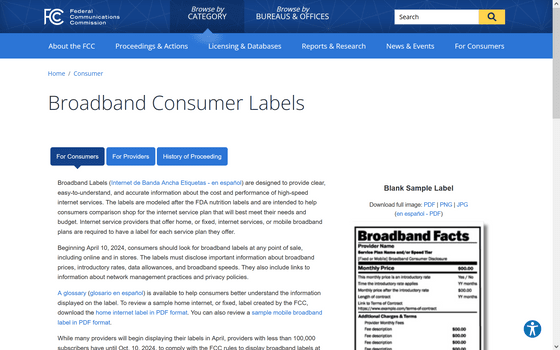A new rule requiring internet service providers to display rates and speeds at a glance has come into force, making it incredibly easy to compare plans from different companies

Internet service providers (ISPs) that provide Internet connection services to consumers often present complicated discount systems that mislead consumers about the official price, or confuse consumers by making communication speeds unclear. In order to improve this situation, the Federal Communications Commission (FCC) has implemented rules that require ISPs to provide easy-to-understand information about their services and performance.
Broadband Consumer Labels | Federal Communications Commission

Consumers will finally see FCC-mandated 'nutrition labels' for most broadband plans - The Verge
The template for the information that is now required to be displayed is as follows. In addition to the information 'How much is the monthly fee?' that must be displayed in the most prominent position at the top, detailed information such as whether the monthly fee is a trial fee or not, and if so, how much it will be after the official launch, must also be clearly indicated. In addition to the fee, average download speed, upload speed, and latency must also be displayed. In addition, ISPs that offer multiple services must create and display similar labels for each service.

The label above is modeled after the Food and Drug Administration (FDA) nutrition label. In Japan, you can check the ingredients and calories of food on the packaging, but ISP has applied something similar to this to its products.
The requirement to display these labels has been in place since April 10, 2024, and consumers can file complaints with the FCC if they find an ISP that does not display the labels. Small ISPs with fewer than 100,000 subscribers have a little more time to comply, and are required to do so by October 10, 2024.
Most of the information on the labels is publicly available from ISPs, but it takes a lot of time and effort for consumers to find it all. Creating such labels makes it easier for consumers to compare rates and speeds between companies, but major ISPs have been campaigning against the regulations since before, saying that creating labels is costly.
Below is an example of a Verizon label. Verizon calls their label the 'Broadband Facts Label.'

Google calls the labels 'Broadband Customer Labels.'

T-Mobile calls it the 'Broadband Nutrition Label.'

Related Posts:
in Web Service, Posted by log1p_kr







